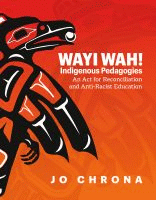Growing up, I always looked forward to the Thanksgiving holiday. It was a time to gather with family and celebrate being thankful for life’s blessings. As I grew older and encountered multiple perspectives on the significance of this historical event, I knew it would be important to approach this celebration in new and different ways in my classroom and with my own children.
The perspective that is most often overlooked when it comes to Thanksgiving is that of Indigenous Peoples and First Nations even though they are a very key part of the story. Dr. Star Yellowfish, Director of Native American Student Services in Oklahoma Public Schools, states that “Thanksgiving is a great entry point for learning about the culture of America’s first people. Teaching truth, and learning from it, helps us honor all our students and build stronger relationships with each other.i”
Yellowfish offers some great tips and resources for revamping how we teach or think about Thanksgiving. Her examples include:
- Replace “Indians” and “Pilgrims” with more specific names: Wampanoag, and English or Separatists. As responsible educators, we need to encourage our students to use more accurate terms.
- Tell the story of the Wampanoag who were instrumental in helping the English survive. It’s important for students to learn that Wampanoag people still exist today.
- Research Native tribes in your area and invite them to give a lesson at your school. There are over 500 tribes spread throughout the U.S. If you don’t have tribes close to you, build partnerships with Native American organizations and local museums and universities.
- Focus on the importance of the harvest with young students. Teach them about the role of the three “sisters”—corn, beans, and squash—in Native cultures.ii
By taking a deeper look at how Indigenous Peoples celebrate the harvest season through storytelling, dancing, gathering, and honoring the sacrifices of their ancestors, educators can honor the role they had in this holiday as well as help rewrite the traditional narrative.
 In Jo Chrona’s book Wayi Wah! Indigenous Pedagogies, An Act for Reconciliation and Anti-Racist Education she states, “While it is not conventional to capitalize Reconciliation, I do so to emphasize the specific process addressing the harms of colonization on Indigenous Peoples [in Canada]. When I use this word, I am imbuing it with meaningful action rather than merely performative tasks.” In rethinking how to include these important aspects of Thanksgiving, it would be meaningful to consider the various ways to uplift and celebrate Indigenous Peoples’ perspectives and traditions as a Reconciliation to them. By creating meaningful discussions, highlighting multiple perspectives, and taking an active role in the season’s celebrations, we can enlighten our youth about the real meaning of Thanksgiving.
In Jo Chrona’s book Wayi Wah! Indigenous Pedagogies, An Act for Reconciliation and Anti-Racist Education she states, “While it is not conventional to capitalize Reconciliation, I do so to emphasize the specific process addressing the harms of colonization on Indigenous Peoples [in Canada]. When I use this word, I am imbuing it with meaningful action rather than merely performative tasks.” In rethinking how to include these important aspects of Thanksgiving, it would be meaningful to consider the various ways to uplift and celebrate Indigenous Peoples’ perspectives and traditions as a Reconciliation to them. By creating meaningful discussions, highlighting multiple perspectives, and taking an active role in the season’s celebrations, we can enlighten our youth about the real meaning of Thanksgiving.
Here at Mackin, we offer a wide and diverse selection of titles to help educators navigate a pathway of inclusion that features the ideas and research above. Here is a list of titles that might be just what you’re looking for to help you rethink the idea of Thanksgiving, and to add Indigenous voices to your library!
References:
(i, ii) Holcomb, Sabrina. “Native educators say Thanksgiving lessons can be accurate, respectful and still fun- here’s how.” Published November 11, 2020. Nea.org.
Chrona, Jo. Wayi Wah! Indigenous Pedagogies an Act of Reconciliation and Anti-Racist Education. Winnipeg: Portage & Main Press, 2022.






